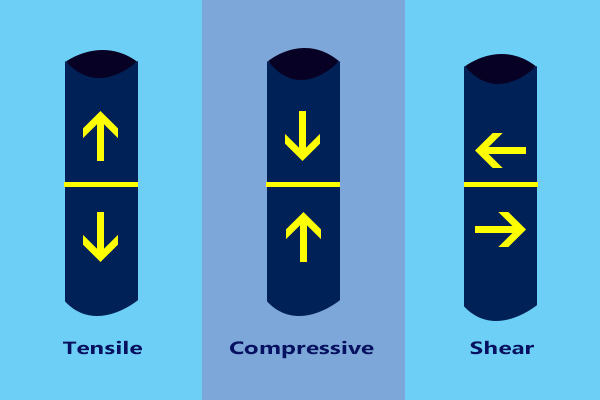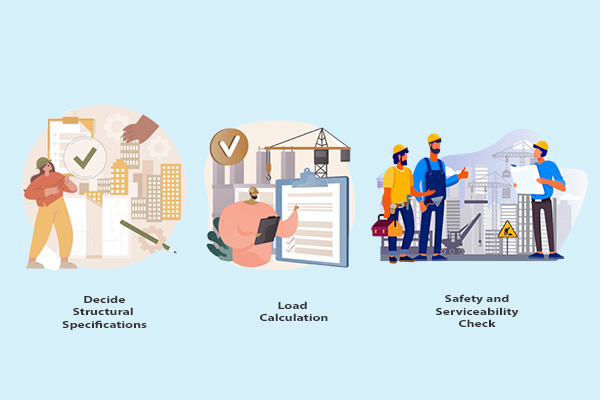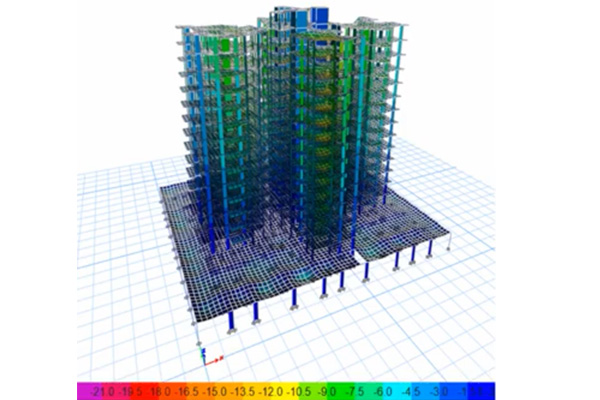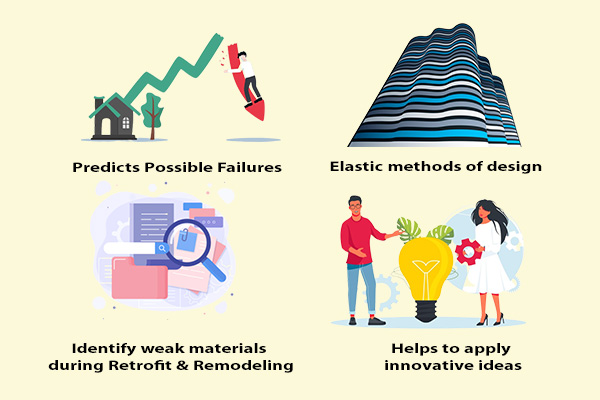Eventually, as the building and its structure are tending more complex, stress analysis is becoming a crucial part of the design and construction process.
Commercial buildings have to meet the demand of application flexibility and adaptability, energy efficiency, high quality, and other functionality. Several members like struts, beams, columns, and walls make a commercial building structure. So, it is imperative that the structure of a building bears & supports high loads and maintains its structural integrity.
Stress analysis helps identify how much stress and strain from loads and force result from these loads a structure can withhold and remain intact to prevent structural failure. Structural modeling, computational simulation, experimental testing techniques, and finite element analysis are some of the methods that help identify internal stress, forces, and deformations.
What is Stress Analysis in Buildings?
Stress Analysis, also known as stress-strain analysis, is a process and computational method to identify the load consumption of a building structure resulting from the force application on different parts of the structure. The process ensures structural integrity and reliability by providing solutions to different strains caused due to loads and internal forces. For example, stress analysis helps calculate shear force and bending distribution on beams during building design.
The primary function of any physical structure is to carry a load. A building structure consists of several prominent members, struts, ties, columns, beams, and walls. It is essential to know the effect of stress on these structural members and the structural problems interlinked to it. Stress analysis helps counter evaluation of structural analysis based on fatigue assessment and failure analysis process.
Types of Structural Stress in Construction

Structural members usually consist of three basic types of stress.
Tensile Stress
Stress acting on a structural member makes it long, and the member is said to be under tensile stress.
For resisting tensile stress, steel gets widely used as a structural material in construction.
Ties that connect the bottom of the rafters on the opposite side of a roof structure should be made of non-ductile material to withstand tensile stress.
Compressive Stress
Compressive stress makes a structural member push together or short. A strut under constant compression stress can cause structural deformation and other structural problems as parts of the frame are interlinked.
Shear Stress
Shear stress makes the particles of the material slide relative to each other vertically or diagonally, leading to shape deformation, such as vertical forces acting on a cantilever can make it shear off at the wall junction. Shear stress can get measured across the unit area of a structural member.
Process and Methods to Conduct Stress Analysis in Buildings

The rising complexity of commercial buildings with the demand for application flexibility, sustainability, and several other functionalities has made stress analysis a crucial step in the designing and retrofitting process.
The usual stress analysis process followed in the building design and retrofitting is as follows.
1. Decide Structural Specifications
For constructing any commercial build, an initial specification of the building, such as structural exteriors & interiors, floors system, electrical, plumbing, etc., are presented.
The selection of materials such as steel, reinforced concrete, and others is significant while designing a structure. It helps prevent loss by selecting materials with a high safety factor for the load they expect to carry.
2. Load Calculation
The structural members, struts, ties, beams, columns, and wall frames of the commercial build require to carry loads and proper load calculation. Such as, the column is a compression member and a vital element of every reinforced concrete structure that helps transfer a load of superstructure to the foundation safely.
Different loads that a structure experiences are dead loads, live loads, wind loads, earthquake loads, snow loads, etc.
The use of advanced Structural design software, like STAAD Pro or ETABS, for designing high-rise buildings and calculating several internal and external loads is very effective.
3. Safety and Serviceability Check
The internal and external load calculation results help identify the internal stress distributions and strains.
Then, structure safety and serviceability checks ensure that it will resist loads with any failure, excessive deformation, and any danger of collapse.
Stress analysis brings unsafe construction or unserviceable ones to notice.
And also identify if the structure is under-designed or uneconomic. Accordingly, make required modifications and repeat stress analysis to create a flawless structure design.
Methods of Stress Analysis

The stress analysis method commonly used for building frames are computational simulation, experimental testing techniques, analytical mathematical modeling, or a combination of methods.
Structural modeling – It is a mathematical modeling approach and one of the standard methods for stress analysis. The method is based on an idealization of the actual structure using simplifying assumptions on geometry, loads, and boundary conditions. It develops a mathematical model to predict deformations, internal force, and stresses.
Two different types of structural modeling used are computer models based on numeric solutions and analytical or hand calculations based on closed-form solutions.
Finite Element Method or Finite Element Analysis (FEA) – This is the most common numeric method that solves partial differential equations in two or three space variables. In addition to structural analysis, FEA is also in use for the field of heat transfer, fluid flow, mass transport, and electromagnetic potential.
Advantages of Conducting an Effective Stress Analysis

Conducting a stress analysis brings numerous benefits to the overall structure and its design. Some of the advantages of stress design methods are
Predicts Possible Failures
Various stress analysis methods calculate and predict if the structural members behave as preferred under the agreed loading. The analysis process helps forecast failures and determine the accuracy of the design and structure.
Elastic methods of design
It supports an elastic design method by analyzing the linear stress-strain relationship between structural members by assuming the working stress is a fraction of the material’s elastic limit. Design loads and required internal force are applied to the structural elements, and adequate design strength is provided.
Identify weak materials during Retrofit and Remodeling
We can use stress during retrofit and project remodeling and even identify their weak materials, as it plays a vital part in defining a structure’s strength and sustainability.
Helps to apply innovative ideas
Stress and structural analysis help apply innovative design ideas to cope with structural loads. Several different design ideas are experimented with to increase efficiency and accuracy and prevent structural failure.
Ensure Structural Integrity of Commercial Buildings Through Stress Analysis
The rising innovation in construction is behind complex structures with high-rise buildings, multi-disciplinary integration, and sophisticated systems. Supporting the AEC industry with a range of structural engineering services for years, eLogicTech advocates for Stress Analysis as an effective and mandatory tool for commercial buildings. To identify stress-strain on the structure and create an effective design that can stand up under several internal and external load conditions, contact our team of engineers.







